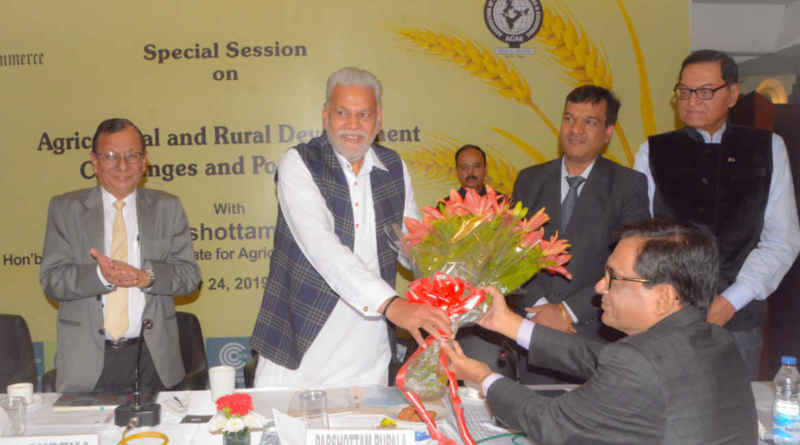All government body should focus on farming and diary products for earning revenue
Ambar Bhattacharya, abptakmaa, Kolkata, 25th Nov 2019 : Currently in its 188th year, Calcutta Chamber of Commerce is the oldest chamber not only in India, but in the entire Asia. The Chamber has been in the forefront of serving industry and trade. The Chamber while encouraging excellence in different fields of human endeavour also promotes debates on issues pertaining to Civil Society.
On this occasion distinguished guests present were Shri Parshaottam Rupala, Hon’ble Union Minister of State for Agriculture and Farmers Welfare, Hon’ble Consul Generals, Deputy High Commissioners, senior members of the diplomatic core, Presidents of Fellow Chambers of Commerce, most respectable leaders of the business fraternity and leaders of our civil society and Jitendra Lohia (President, ACAE), Shri Rajeev Maheshwari, CA Shanti Swarup Gupta (Vice President, ACAE).
Agricultural development is central to economic development of the country. India is known as Land of Villages, about 67% of India’s population lives in villages. Agriculture is the largest and dominant sector of our economy providing livelihood to about 70% of the population of India. Agriculture is the backbone of the Indian economy.

India’s agriculture production has been increasing on an average at about 3.6% annually since 2011, sustained by improved access to inputs such as fertilisers and seeds, as well as better irrigation and credit coverage. The sector has also been diversifying from grains towards pulses, fruit, vegetables and livestock products, largely driven by evolving demographics, urbanisation and changing demand patterns.
India has achieved a significant fall in the proportion of the population that is undernourished, from around 24% in 1990-92 to 15% in 2014-16. Moreover, it has also emerged as a major agricultural exporter of several key commodities, currently being the largest exporter of rice globally and the second largest of cotton. But for these past successes to continue into the future, India will need to accelerate existing reform efforts and to launch bold new policy initiatives.

The fact remains that Indian farmers have failed to transform increased output of horticulture items into increasing their income. Instead, farmers face the problem of plenty due to non-availability of cold storage and processing facilities. They sell out their crops at less than cost of production and face distress. The situation is grim in the states of Madhya Pradesh, Uttar Pradesh, Karnataka and Haryana.
In addition, the declining size of landholding not only brings the farm size to unviable levels but also makes difficult to take advantage of mechanization. This difficulty may be resolved through land consolidation process and also encouraging farmers to adopt co-operative farming.
A sound mechanism needs to be put in place so that small and marginal farmers are able to access funds through formal channels rather than depending to a large extent on informal channels.
There is also a need to undertake reforms on agriculture land policy – land leasing, tenancy law, contact farming – so that tenants can also be eligible to take advantage of various government schemes as well as bank credit, and they can make adequate investments on land to raise its productivity on a sustained basis.
Boosting agriculture growth and doubling farmers’ income are main objectives of agriculture action agenda of the government for making New India. In addition to expansion of coverage of on-going schemes and enhanced budget allotment, GOI launched a number of new schemes to meet its action agenda. Micro irrigation scheme, setting up new soil testing laboratories for Soil Health Card Scheme and Promotion of organic farming scheme are notable new schemes launched to boost agriculture productivity.
To ensure remunerative prices to the farmers for their produce, the government has launched e-NAM, an electronic platform by unifying more than 400 mandis across the country. PM FasalBimayojna was launched; contact farming and land leasing to be adopted and implemented in the states for the purpose of safeguarding and enhancing the income of farmers.
In order to promote agricultural and rural development, the Government of India places high priority on reducing poverty by raising agricultural productivity. However, concerted actions will be required to build a solid foundation for a highly productive, internationally competitive, and diversified agricultural sector. Publicity : Launcherz.



